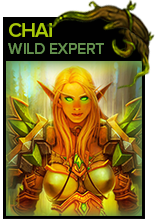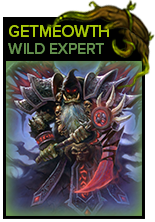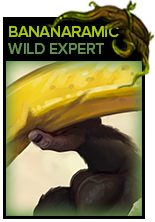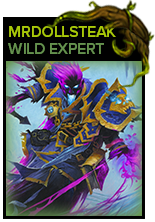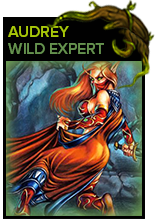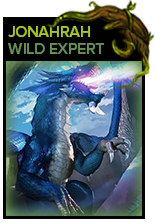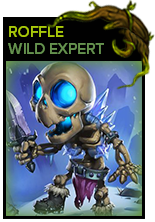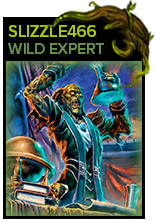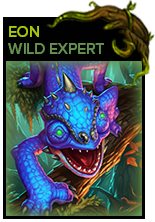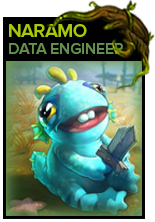
Welcome back to the vS Wild Report! We’re the experts from r/WildHearthstone, and we have partnered with Vicious Syndicate to create the Wild Data Reaper Report. We will be contributing the write-ups and analysis for the report. Since WW’s launch, we have collected 25,000 games.
If that number seems pretty low to you, it’s because it is. The excitement of a new expansion tends to bring back many players to Hearthstone, even the Wild format, where rotations don’t happen. While there is a feeling among players that there are more people participating in the format as a whole, this isn’t reflected in the size of the data pool we collected. Therefore, we, members of the Wild Hearthstone community, and the members of the Vicious Syndicate Data Reaper would like to start out this report with a simple request: please sign up to allow vS to use your game data; it’s easy and helps us provide quality content! https://www.vicioussyndicate.com/data-collection/
The Witchwood card reveals felt lackluster to many as they had grown accustomed to the power level introduced in the Knights of the Frozen Throne and Kobolds and Catacombs. In the first expansion of the Year of the Raven, there were very few cards that people thought would impact the Wild meta. The few cards that did make an impact though, had quite the impact. Baku the Mooneater and Genn Greymane introduced new deck building restrictions at the reward of upgraded or cheaper hero powers. Whenever cards of this nature – deck-restriction legendaries with a big payoff – are released, they will likely find a place in Wild due to the much larger card pool. We have seen that just these two cards helped introduce many new decks, including 3 top tier decks in Even Shaman, Even Paladin, and Odd Rogue. Other cards, such as Lord Godfrey, Rotten Applebaum, and Azalina Soulthief have also found themselves in top tier decks. There were also some major flops as highly-anticipated cards such as Lady in White and Shudderwock failed to live up to the hype. It is safe to say that the Witchwood definitely shook up the meta, and that’s even before the upcoming announced nerfs.
Quick Links
Class/Archetype Distribution | Matchup Winrates | vS Power Rankings | Meta Score | Class Analysis & Decklists | How to Contribute | Credits
Frequency and Power Rankings
With much less data, the team was not able to generate significant frequency and matchup statistics that we were comfortable with, though we still have a meta report. The Power Rankings in this report are based off decks with a higher than 1% play-rate from rank 4 to legend. All of these decks are ordered and sorted into their respective tiers and place within the tiers based on their win rates.
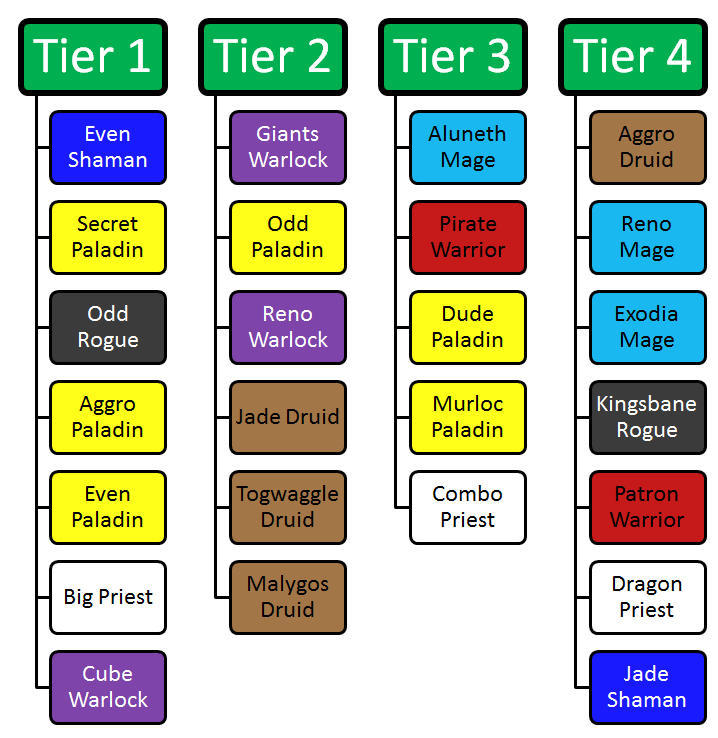
Baku and Genn have had an immediate impact with three archetypes in Tier 1 embracing the Odd/Even theme. Even Shaman utilizes the one-mana hero power and overload in order to manage its curve, and can swing boards with Flametongue Totem, Thing from Below and Sea Giant. With tools to fight for the board, Even Shaman is one of the few decks, if not the only one, that can contest early game Paladin board states. Odd Tempo Rogue’s 2/2 Dagger hero power gives it a massive ability to control the board or just push some extra damage. Even Paladin still has access to Call to Arms and Tarim, so of course the deck would be good, but the 1-mana hero power also enables its consistent curve and threatens to win the game if unanswered, making it formidable in the Wild format.
As usual, Paladin is in a good place. Secret and Aggro Paladins join Even Paladin in Tier 1. Big Priest didn’t gain anything from the Witchwood but continues to terrorize midrange and control decks alike, as many other decks lack tools to effectively combat the endless resurrects. Cubelock, Giantslock, and Renolock all got one tool, but it was an extremely powerful tool: Lord Godfrey. Slower Druid builds received another cycle card, and a game-winning combo in Togwaggle/Azalina. It’s no surprise to see them sitting solidly in Tier 2. Odd Paladin, with no access to Tarim, still is able to exert constant recruit pressure with reliable mass buffs.
Tier 3 sees many of our old friends that didn’t receive any new tools this expansion. Aluneth Mage and Pirate Warrior are still strong options for punishing slower Warlock and Priest decks but are not able to compete with the board pressure applied by Paladins (and now, Shamans). Dude Paladin gets outclassed by Aggro Paladin and Even Paladin in terms of consistency, and Murloc Paladin didn’t get any new tools but remains a solid deck to play on ladder due to the typical Paladin early game power as well as the always dangerous Murloc snowball potential. Combo Priest remains an option for dedicated pilots, who can get the most out of the deck with experience.
Class Analysis & Decklists
Druid | Hunter | Mage | Paladin | Priest | Rogue | Shaman | Warlock | Warrior
If you are a fan of slow Druid decks, then this meta is for you. Jade, Togwaggle, and Malygos Druid are all popular decks you will see on ladder and they are sitting at the bottom of Tier 2.
The new archetype introduced in the Witchwood expansion is Togwaggle Druid. Azalina Soulthief is the card that enables an insane combo with King Togwaggle, Aviana, and Kun the Forgotten King that players are finding faster to pull off (since fewer cards are needed) than the the other popular archetype – Malygos Druid. The combo works by playing Aviana to reduce the cost of your minions to 1 mana, Kun The Forgotten King to refresh your 10 mana crystals, King Togwaggle to swap decks with your opponent, and then Azalina Soulthief to replace your hand with your opponent’s. The idea of the combo is that you are close to or in fatigue when you play the combo, so you are taking your opponent’s deck and giving them an empty or near-empty one. Because you copied their hand, if they play the Ransom spell given to them from King Togwaggle, you can just play your copied Ransom spell and get your opponent’s deck back again. This has turned out to be a powerful combo and multiple players have reached #1 legend with the deck.
Malygos Druid and Jade Druid are largely unchanged. The only Witchwood card that is seeing play in these decks is Ferocious Howl. Then there is our poor friend Aggro Druid who has been pushed into Tier 4. The only way the deck can survive the onslaught of Big Priests, Cube Warlocks, and Giants Warlocks is to use cards like Glacial Shard and Spellbreaker, and unfortunately, even these tech choices don’t help that much.
Baku the Mooneater has given Face Hunter a new face, now using the upgraded Ballista Shot hero power to put immense pressure on the opponent’s life total. Cutting out even-cost cards makes room for some cards that usually aren’t quite good enough to make decklists, like Argent Squire or Arcane Shot. Unfortunately, many powerful even cost cards such as Glaivezooka, Crackling Razormaw, and the secret package, are lost, and the question remains as to whether the odd package is really worth it.
Big Hunter carrying the Kathrena package is still popular, as she gives a massive tempo swing when played, and allows the deck to run a powerful top-end without limiting its ability to play a strong threat each turn. While losing out on cheap Beasts is unfortunate, the package is quite powerful. RenoJackson’s Kathrena Cube Hunter combines the early game secret package with Carnivorous Cubes, Faceless Manipulators and Ragnaros to grind out value in the late-game. Applecat hit #1 Legend NA in April with an anti-aggro list combining Kathrena and the new Witchwood Grizzly. Greater Emerald Spellstone is still a very powerful tempo play, and with Naga Sea Witch being nerfed to 8 mana, Hunter may find the breathing room it needs.
Giant Hunter is not the most popular giants deck by any means, but it’s a legitimate contender. Unlike the Warlock deck, with its multiple Plan B’s, Giants Hunter plays one – the Death Knight – and then uses its powerful tutors to have a very consistent turn 5 combo. Houndmaster Shaw is a powerful new pickup that gives the deck more survivability, letting your giants trade in on the turn they’re played. Wing Blast is also a strong defensive tool, something the deck has been missing.
- Jonahrah’s Giant Hunter
- RenoJackson’s Kathrena Cube Hunter
- Applecat’s #1 Legend NA Kathrena Hunter
- Gunnolf’s Odd Face Hunter
Witchwood did not change Mage in the Wild meta. Jaina remains on the fringes, with each archetype getting very small improvements. Many players have been testing Book of Specters in a number of decks, to varying degrees of success. However, Mage remains fairly weak in the meta, due to each archetype’s vulnerabilities.
Aluneth Mage still proves to be the top class archetype in terms of consistency. It uses powerful secret synergies alongside Aluneth’s draw engine to quickly chip down opponents. The featured list showcases the new Arcane Keysmith, which allows for a decent tempo play on Aluneth Mage’s otherwise weak turn four.
Exodia Mage remains a solid counter pick, gaining Book of Specters from the recent Witchwood expansion. Using the new book, it is able to more consistently find the combo against the decks it counters. The deck is able to aggressively cycle without worrying too much about ruining the combo because of the redundancy Simulacrum provides.
Reno Mage has always been a strong deck against aggressive strategies, but struggles against the mana cheating decks. Builds try to focus on stemming any aggression and reaching Frost Lich Jaina safely. More recent builds have started to incorporate N’Zoth in order to have some late game power in control matchups. The featured list also includes Baron Geddon as an additional anti-aggro tool that works wonders with Frost Lich Jaina as healing.
Even Paladin is Uther’s flashiest new midrange deck. Using Genn Greymane to reduce the cost of the starting Hero Power has proven to be a recipe for success, and Paladin does it particularly well. The featured list, with which Slizzle466 hit #5 legend this month, cuts Tirion for a Silver Sword, allowing the deck to turn on a dime. While it’s one of the more common decks on ladder, we estimate that it has the lowest winrate of the Tier 1 Paladin decks.
Secret Paladin got Bellringer Sentry in the Witchwood, but the card doesn’t seem to have made it into the meta. Most Secret Paladins are still running Call to Arms and Spellbreaker at 4 mana, and running both Bellringer and Mysterious Challenger demands a larger secret package. We’re presenting a traditional-looking list, which takes advantage of the midrange meta to run a haymaker – Dr. Boom – that’s long been too slow for Wild. With a nerf to Call to Arms coming this week, Secret Paladin may adapt to run Bellringer Sentries and a larger Secret package, or weather the storm another way – after all, it always has.
Aggro Paladin, sometimes called Breakfast Paladin, may weather the Call to Arms nerf better than other paladin archetypes. The deck plays some of Wild’s most resilient threats – Nerubian Egg, Haunted Creeper, Shielded Minibot – and uses Paladin’s aggressive buff effects to present opponents with a Catch-22 of a board state.
Traditional Dude Paladin didn’t gain much from the Witchwood, but Muster For Battle and Baku Mooneater have become BFFs 4 Life. Lost in the Jungle, Muster, Quartermaster, and Level Up! are all odd cards, and the upgraded Odd Paladin hero power is a threat that opponents need to respect at all times. Odd Paladin comes in at Tier 2 of our estimated report. Aoierias managed to take the deck to #15 Legend Asia this month.
Murloc Paladin continues to see much more Standard play than in Wild. Both Murloc and traditional Dude Paladins fill out Tier 3 of our estimated report. Even, Secret, and Aggro Paladin are where devotees of Uther, Liadrin and Arthas want to be on Ladder.
- Slizzle466’s #5 Legend NA Even Paladin
- Sipiwi94’s Aggro Paladin
- chai’s Secret Paladin
- GetMeowth’s #1L NA (February) Murloc Paladin
- Aoierias’ #15L Asia Odd Paladin
To no one’s surprise, Big Priest is a dominant force in the Wild metagame. While gaining next to nothing from the Witchwood expansion, it still has the ability to steal games with an early Barnes. More importantly, the slew of Resurrect effects allows Big Priests to efficiently sequence threats while still being able to respond to most board states (including multiple waves of Giants). The future of Big Priest is looking secure as the archetype managed to dodge the upcoming wave of nerfs and should remain a top tier option moving forward.
Combo Priest may be losing a bit of steam after gaining little from the new expansion. In the past, the deck (especially non-Dragon variants) has had trouble with board-based strategies. The continued swarm of Paladins, along with the increasing popularity of Even Shamans, is a bit concerning for Combo Priests.
Dragon Priest continues to see play despite having a difficult time finding wins. Across all ranks, many players still seem dead set on making curve-centric Spiteful Summoner builds work on the Wild ladder; apparently without much success. That said, the Dragon package does offer a lot of flexibility for other Priest archetypes. In fact, a handful of players have piloted a more controlling Dragon Priest list to single-digit Legend ranks thanks to strong answers to Paladin and Shaman boards.
Reno Priest remains an unpopular choice on the Wild ladder. So much so that the deck did not have enough games to register on the current, estimated tier list. We’d be remiss, however, not to at least include Skylight’s Reno Priest list used to reach rank 1 Legend on the NA server.
- Big Priest
- Haze’s Combo Priest
- Dragon Combo Priest
- Spiteful Dragon Priest
- Eon’s Control Dragon Priest
- Skylight’s Reno Priest
The Witchwood meta has breathed new life into the Rogue class. These past few months, the only remotely viable Rogue archetype has been Kingsbane Rogue with Tempo and Miracle rogue fading further and further into obscurity. Witchwood has been able to bring Rogue back to Tier 1 with the Baku the Mooneater Odd Rogue. Rogue now has some variety and isn’t limited to being a hard counter to slower archetypes.
Odd Rogue has immediately shot itself into Tier 1. The archetype appears to be extremely strong with multiple players reaching rank 1 legend with it. Time will tell if the deck is just a fad or if it is a legitimately strong archetype in the Wild format, but at the moment if you want to climb with Valeera, Odd Rogue is your deck. Most lists mimic the builds in Standard with the inclusion of strong Wild staples such as the pirate package, Loatheb, and Dr. Boom.
Kingsbane Rogue remains unchanged in both its lists and its standing in the meta: extremely strong against control and weak to aggro. The matchup against some control decks is so dominant that a fair number of players were asking for the deck to be hit with nerfs but it is unlikely to happen anytime soon. Kingsbane Rogue remains, for the foreseeable future, the go-to deck to punish slow strategies.
Shaman has shown to be one of the most successful classes to use when climbing the ladder in the Wild Witchwood meta. Even Shaman is at the top of Tier 1, proving itself to be a dominant force; however, other decks from this class seem to fall off, with Aggro Shaman, Jade Shaman and Shudderwock Shaman failing to hold their own against the meta’s other dominant decks.
Even Shaman, one of the newest decks from the Witchwood expansion, is a powerful and consistent midrange deck. Thing from Below and Sea Giant synergize well with the one mana hero power to create large tempo swings. Players such as RenoJackson and Awedragon both achieved #1 legend during the month of April piloting mostly this deck.
A deck that has seen a large decrease in both its play-rate and win-rate is Aggro Shaman. The deck is able capitalize on Shaman’s cheap burst cards such as Lava Burst, Lightning Bolt and Crackle, while also having access to strong aggressive minions like Tunnel Trogg, Totem Golem and the classic 4 mana 7/7. But, it struggles against the board dominant decks of the meta. Aggro Shaman didn’t pick up any new cards this expansion, and remains largely unchanged.
Shudderwock Combo Shaman sees minimal play and is found very low on the tier list this month. As a deck that was very hyped up and seemed to be extremely popular as a choice during the first week of the expansion for both Wild and Standard, it has nearly dropped out of sight in the more refined meta. The deck’s inability to deal with Naga turns or other forms of mana cheating makes it very hard to gain wins with.
Jade Shaman is the only deck aside from Even Shaman to see any significant play and to appear in the tier list. The most effective build of this deck seems to be a package of Jade battlecry effects and N’Zoth the Corruptor. Aside from the classic Jade package, cards such White Eyes, which hasn’t seen very much play since KFT Control Shaman, can be found in some lists today. Control Shaman is able to beat aggressive decks quite handedly, but similarly to Shudderwock Combo Shaman, struggles to deal with big Naga Sea Witch turns.
- OfMonCala’s Al’Akir Even Shaman
- Awedragon’s Totemcarver Even Shaman
- RenoJackson’s Even Shaman
- Controltheboard’s Aggro Shaman
- Jade Shaman
- Shudderwock Shaman
Warlock has remained one of the top classes in Wild following the release of the Witchwood, having received a new and impressive board clear in Lord Godfrey, which has been strong enough to make it into most of its Tier 1 and 2 decks.
Cubelock has crept into Tier 1, piloted by players such as sipiwi94 and Dean to top legend finishes. The deck keeps the strong clears against aggressive decks that it had in previous seasons, and with the additional AOE of Lord Godfrey, can continue to fight against stronger midrange boards in the later stages of the game.
Giantslock sits at the top of Tier 2, being only slightly weaker than its Cube cousin because of its susceptibility to tech inclusions such as Equality, Poison Seeds and Potion of Polymorph. The power of the deck is much the same as previous expansions, and there has been relatively little to no experimentation with the lists following the Witchwood apart from the inclusion of Lord Godfrey.
Renolock has enjoyed a huge surge of popularity and effectiveness since the last report, being piloted by xCrouton and GetMeowth, as well as others, to legend. Once again, it’s another deck greatly helped by the impressive power of Lord Godfrey. For a deck that only runs single copies of cards, an additional flexible late-game clear is exactly what it needs. In addition to Godfrey, cards such as Rotten Applebaum and Curse of Weakness have also popped up in some lists to great effect.
There was a buzz of excitement with the new Witchwood cards being released, as Garrosh was hoping that the introduction of a new mechanic to his arsenal, Rush, would help bring him back from the depths. Alas, Rush was another keyword that just seemed to fizzle out. The Rush mechanic itself wasn’t enough to bring back Tempo Warrior or Dragon Warrior to any sort of relevance in the meta game. The most that the rush mechanic saw play in was slotting into Pirate Warrior and Patron Warrior to help these decks maintain board control while pushing face damage.
In the Witchwood, players have seen success with Pirate Warrior, both with and without some Rush minions. Pirate Warrior have mostly found success picking on the slow Warlocks and Priests of the meta, while the rush minions give pilots a chance against Paladin and Shaman openings.
If you’re seeing a lot of Paladins (especially Odd ones) or you just want to gate keep any Paladin players from hitting that next rank floor, then Patron Warrior is the deck for you. Full of whirlwind effects, rush minions, and the namesake card Grim Patron, Patron Warrior ends up being extremely successful against the token based gameplan of Paladin while not having much game against any other decks in the field, as shown in the low overall win rate.
- Corbett’s Pirate Rush Warrior
- Pirate Warrior
- RenoJackson’s Fatigue Warrior
- ControltheBoard’s Patron Warrior
Our Data Reaper Project, including the Data Reaper Live has 3,200 active contributors. Without them, this project would not be possible, so we’d like to thank all of our contributors for their help.
Preparing our weekly article requires a significant amount of time and effort from many individuals. We would like to wholeheartedly thank our current Patreons, whose generous donations help us fund computing and server costs.
vS Gold is a new membership plan aimed to support our efforts towards improving our content and data analysis while receiving some bonuses and extra features.
Contributors
Here are all the people that participated in bringing you this edition of the [Wild] vS Report:















